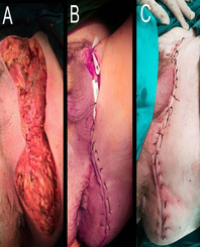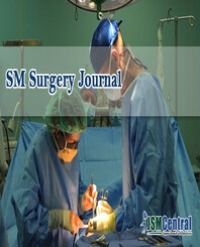
Two Stage Repair Using Lateral Avancement Flaps (Skin and Fat) for Medium-Large Perineal Defects
We present the case of a 40-year-old man treated for Fournier gangrene. After the resection of necrotic tissues, a large perineal defect remained, extending to the left inguinal area (Figure 1A). A two-stage repair was performed, using lateral advancement flaps, with the detachment of skin and fat. In the first stage, lateral flaps of skin and subcutaneous tissue were detached from the posterior perineum for advancement and closure, and brought towards the anterior perineal area (Figure 1B), in preparation for the second stage, in which complete closure was achieved, applying the same technique (lateral skin-and-fat flaps) (Figure 1C).
Pérez Lara FJ1*, Ferrer Berges A2 , Hernández González JM1 , Espejo Reina MJ3 and Oliva Muñoz H4

